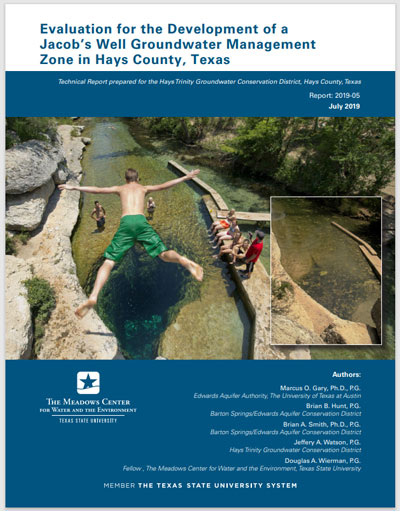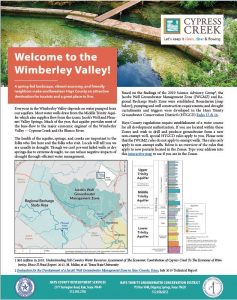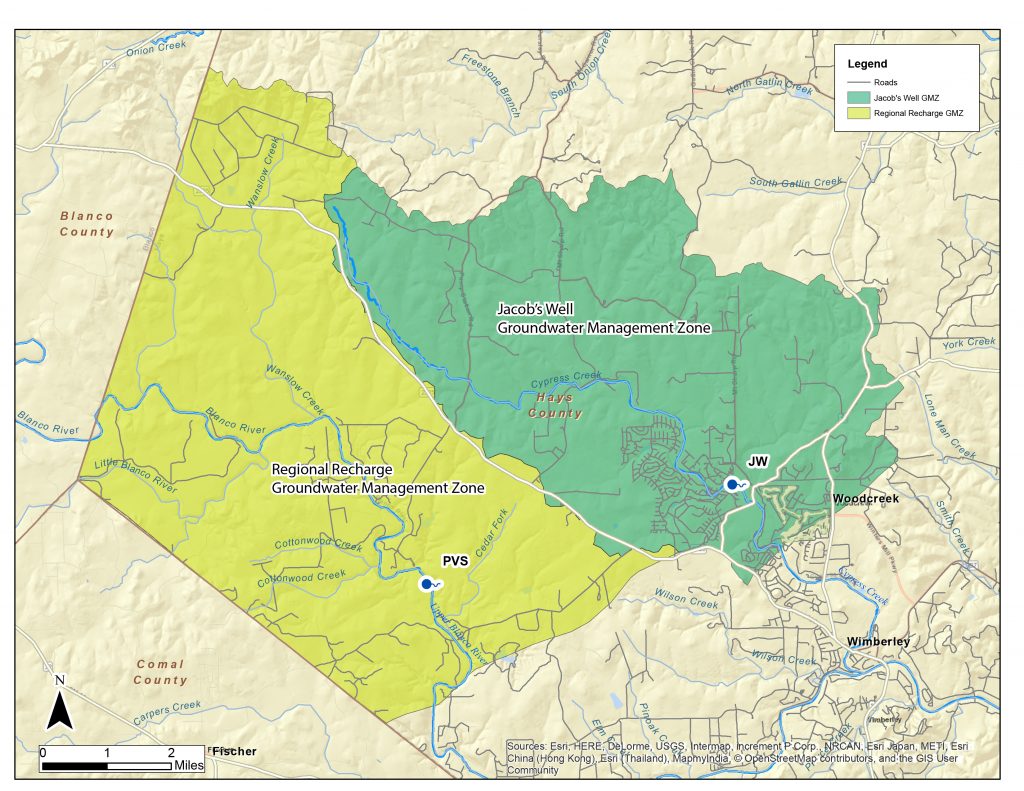A big win for the Cypress Creek Protection Plan, groundwater users, and fans of Cypress Creek and the Blanco River: On March 5, 2020, the Hays Trinity Groundwater Conservation District Board of Directors passed Rule 15, creating the Jacob’s Well Groundwater Management Zone.

The WVWA has long supported tools such as this one to better protect groundwater and flow at Jacob’s Well and Cypress Creek. The recent HTGCD press release explains: The District’s drought-response rules, including Rules 15 and 16 (Regional Recharge Study Zone), were developed after a comprehensive scientific study and lengthy stakeholder vetting process. The multi-agency, technical committee was led by hydrogeologists from the Edwards Aquifer Authority, Barton Springs/Edwards Aquifer Conservation District, and the Meadows Center for Water and the Environment and published the scientific findings in July 2019.

A deliberate, year-long stakeholder process sought consensus and management guidance to develop these rules. Stakeholder participants including Hays County Precinct 3, local water utilities, developers, Wimberley Valley Watershed Association, Blue Hole, the Villages of Wimberley, Woodcreek and Wimberley, local business owners, and others reached accord on large-volume, commercial pumping limitations during drought.
With the Jacob’s Well Groundwater Management Zone (GMZ), the HTGCD can now limit new permits within the GMZ, incorporate monthly pumpage monitoring for drought restrictions for permit holders with over 2 acre-feet per year annual production, and therefore, better coordinate groundwater use—particularly during drought.

Background Information on the JWGMZ:
A Groundwater Management Zone has been proposed to protect sustainable spring flow from Jacob’s Well into Cypress Creek. The JWGMZ is located in the upper Cypress Creek Watershed and would cover approximately 32 square miles located around and north of Jacob’s Well. The Meadows Center for Water and the Environment at Texas State University recently published a report titled, “Evaluation for the Development of a Jacob’s Well Groundwater Management Zone in Hays County, Texas.” Marcus Gary, EAA Field Operations Manager and Hydrogeologist, chaired the report’s technical team, which was comprised of representatives from the Barton Springs Edwards Aquifer Conservation District, Hays Trinity Groundwater Conservation District, and the Meadows Center for Water and the Environment.
The Guadalupe Blanco River Authority, along with the Wimberley Valley Watershed Association, the Texas Land Trust Council, the Friends of Blue Hole, and 26 other community members, landowners, and water supply companies served on the stakeholder committee which was tasked with reviewing the technical report and offered recommendations to the Hays Trinity Groundwater Conservation District for adoption into the JWGMZ.
Jacob’s Well is a karst spring, which originates from the Middle Trinity Aquifer. It is located in the Cypress Creek watershed in Wimberley, Texas. In the past, the spring has stopped flowing due to pumping influences in the areas that surround it. The published report provides a scientific framework to potentially aid the Hays Trinity Groundwater Conservation District in developing policy changes to maintain the spring flow at Jacob’s Well by recommending the establishment of groundwater management zones.
One of these areas has been defined as the Jacob’s Well Groundwater Management Zone (see Figure 1), in which a reduction of pumping in this zone during periods of drought could help maintain the spring flow. The second defined area, Regional Recharge Area Groundwater Management Zone, contains the largest documented spring in the Hill Country Trinity Aquifer, known as the Pleasant Valley Spring (PVS). The spring has a measured range from 12 to 60 cubic feet per second. At its highest, that amounts to about 27,000 gallons per minute! The spring flow supplies water to the Blanco River, which directly feeds into the Edwards Aquifer.
“Maintaining spring flow into Cypress Creek and the Blanco River is essential for our local economy and for the health of our regional ecosystems,” said Wimberley Valley Watershed Association (WVWA) Executive Director David Baker, a member of the stakeholder committee for the Jacob’s Well GMZ. “Establishing management zones is something the WVWA has been advocating for since 2010. We were already over-pumping the aquifer in 2000 when Jacob’s Well stopped for the first time in recorded history. Even developers and water utilities represented on the task force recognized that keeping the springs flowing at Jacob’s Well and Pleasant Valley – and keeping the water clean and healthy – is a benefit to everyone.”
Through collaboration, efforts such as these affect policy changes that can be instituted to maintain the integrity of naturally occurring springs and aquifers. The scientific technical committee of this report has provided science based research to be considered, and continued research will be conducted to further develop an understanding of the Regional Recharge Area Groundwater Management Zone.
Original story published in the Autumn 2019 EAA News Drop, a quarterly magazine published by the Edwards Aquifer Authority.
Useful Links
Resources and Publications
-
- Press Release: New Jacob’s Well Groundwater Management Zone (HTGCD, 3/23/2020)
- Evaluation for the Development of a Jacob’s Well Groundwater Management Zone in Hays County, Texas (Technical Committee Report, Meadows Center, 7/2020)
- Biological Inventory and Monitoring at Jacobs Well (Zara, 2011)